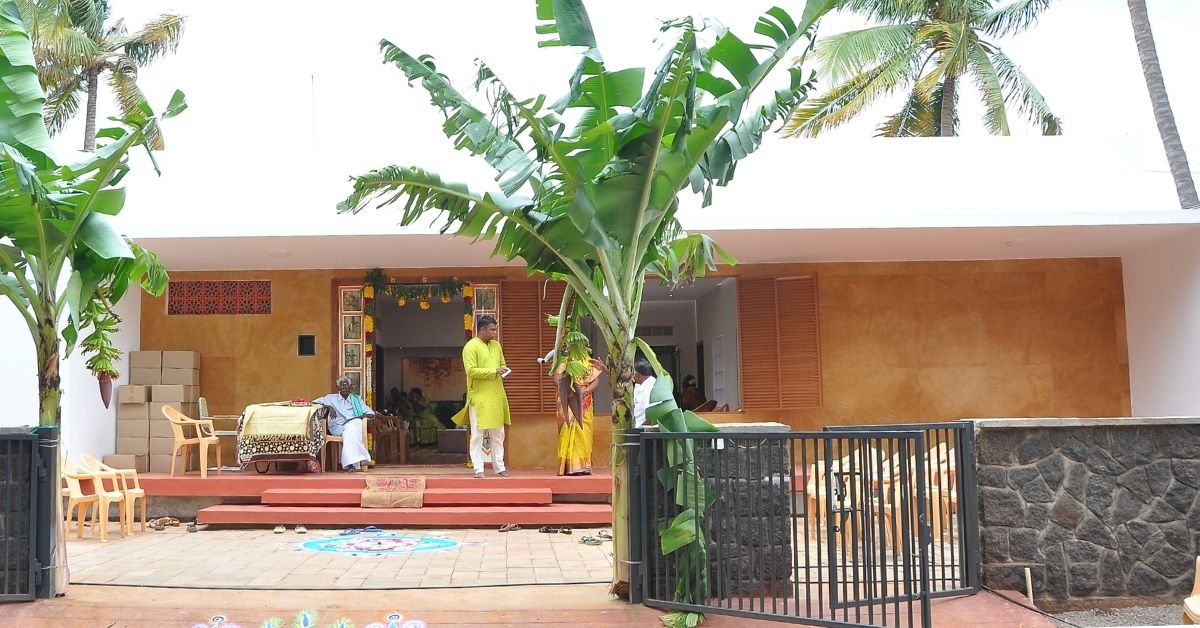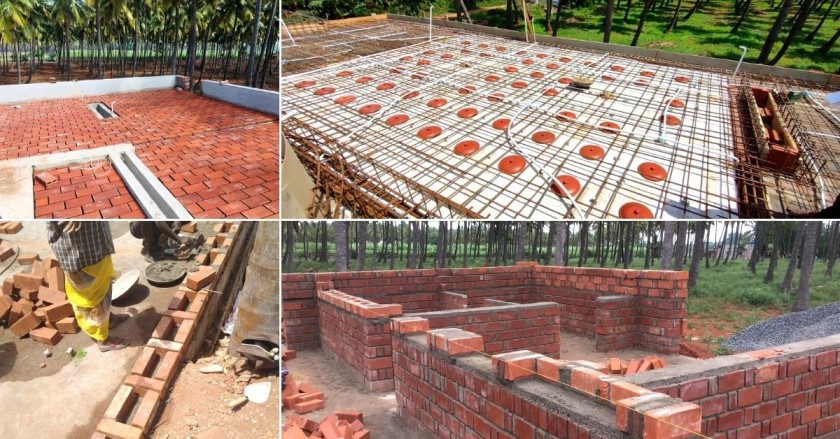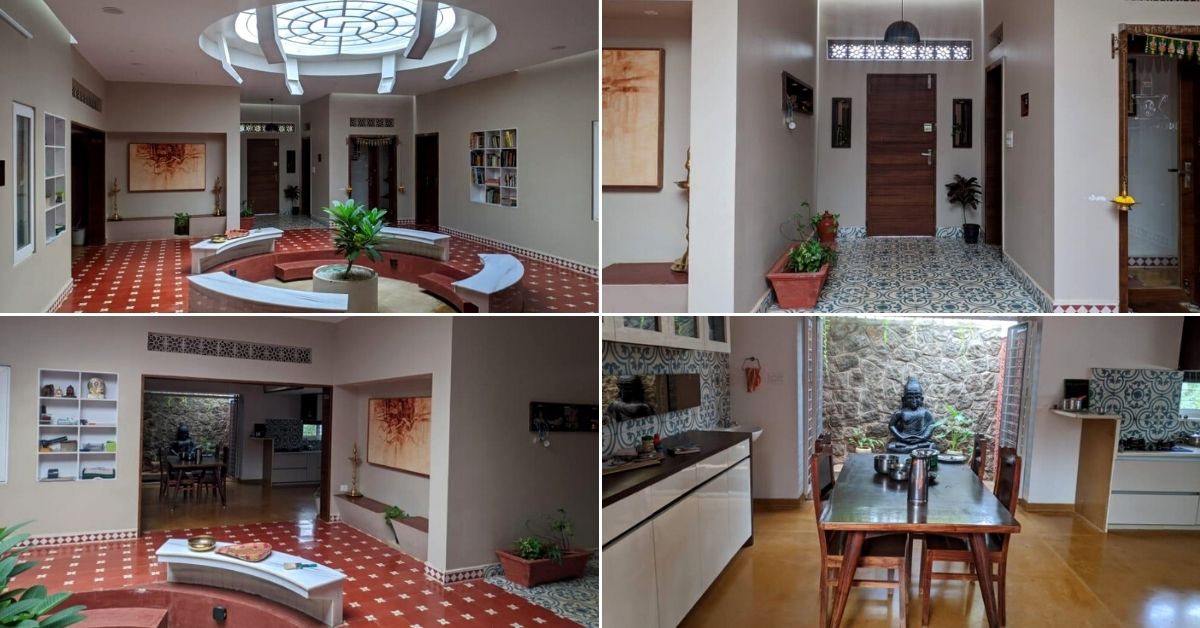Building a sustainable house was a dream come true for Balasunda Kaushikan, a Bengaluru-based architect. Hailing from Hanumanthanpatti in Theni district of Tamil Nadu, Kaushik always wanted to build a house in his village.
Kaushik who has been working as an architect for the past few years in different cities like Dubai, Mumbai and Bengaluru, left his job in 2019 to start an architectural firm in Bengaluru.
“I used to stay in a rented house in my village with my parents. So, when I started my firm, I decided to fulfil my dream of building a sustainable house of my own. My education and the experience I gained over the period made me realise that it’s essential to choose sustainability in our life,” architect Kaushik tells The Better India.
In 2020, he built his dream house on 12 cents in the 4 acres of his ancestral land at Hanumanthanpatti, only using locally-sourced materials most sustainably. “I was very particular about building a sustainable house because I feel it is high time to work towards reducing the carbon footprint and this is my humble attempt at it,” says the 29-year-old.
The construction materials were procured from areas within a 10 km radius of the house, says Kaushik who believes in staying close to his culture and roots. “I tried to bring in regionalism, an architectural approach where the entire construction will be based on aspects such as climate, geography and topography of the region,” he says.
Reducing Energy Consumption

Besides sourcing materials locally, Kaushik says that he has built his house in such a way that, throughout the day, there’s natural light inside the house. He further explains, “I’ve tried my best to make nature a big part of my house. So, I used several passive solar designs and techniques that help in providing sunlight throughout the day for lighting the interiors. It helped us reduce energy consumption to a great extent.”
Apart from using passive solar methods, the house also makes use of solar energy for everything except for a few heavy-duty appliances like the washing machine, mixer grinder, etc., says Kaushik.
He adds, “We have cut down the monthly power consumption by around 70 per cent by using solar energy.”
The 3000-sqft house was built using the rat-trap bond method, introduced by the British-Indian architect Laurie Baker, adds Kaushik. He further explains it as a brick masonry method of constructing walls where the bricks are placed in a vertical position, which creates a cavity in the wall, thereby reducing the number of bricks and mortar used during construction.

Another sustainable technique adapted by him was the load-bearing technique where the walls are built as an active structural element of a building instead of pillars. Kaushik explains, “The load-bearing technique is very cost effective. Another cost-effective method I used was the filler slab technique on the roof, where we used terracotta materials like mud pots, bowls, etc. in between the concrete, thereby reducing the load on the roof, reducing the concrete volume and providing better thermal insulation.”
Talking about ventilation, Kaushik says, ”I am very particular about lighting and ventilation. So I built a big courtyard right in the middle of the house which helps in lighting the interiors with natural light as well as in keeping the house cooler. I have also implemented cross ventilation and the stack effect throughout the house. These methods help in better air circulation and thereby keeping the house cooler.”
He adds, “It is always 3 to 4 degrees cooler than the outside and we don’t need an air conditioner inside the house,” says Kaushik.
Zero Waste Concept
For waste management, Kaushik has set up a biodigester soil tank instead of a septic tank. He says, “I have implemented a zero-waste concept in my house. The biodigester tank degrades and converts human waste into water which we use for gardening purposes, and the methane gas produced is used in our kitchen.”
Besides using a biodigester tank, Kaushik has also set up a biogas tank with a 10-litre capacity dedicatedly for managing kitchen waste. “The biogas produces enough methane to generate good blue flames for at least an hour a day,” he adds.
A rainwater harvesting system and a rainwater recharge well are also in place at Kaushik’s house. He says, “The rainwater collecting well has a capacity of 10,000 litres and I have constructed another well close to the tank to collect the excess rainwater that overflows from it, which will help in recharging the groundwater levels.”

Kaushik’s house is named ‘House of Gardens’ as it has tiny green patches on every corner and he says that one could catch a glimpse of it from anywhere in the house.
The flooring of the house— using red oxide and Athangudi tiles—was inspired by the Chettinad style of houses. “I sourced the Athangudi tiles from a nearby village called Chinnalapatti. Athangudi tiles are handmade tiles and it gives a very smooth finish since it’s made on glass. I was very particular about using earthy tones in my house and Athangudi tiles added a special charm to it,” says Kaushik.
The house was built in eight months for Rs 55 lakh. “The overall cost is much cheaper than that of building a house using conventional methods,” he says.
(Edited by Yoshita Rao)
No comments:
Post a Comment